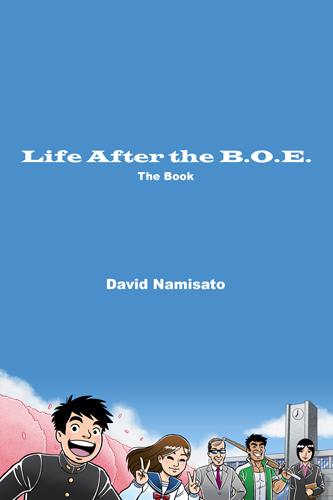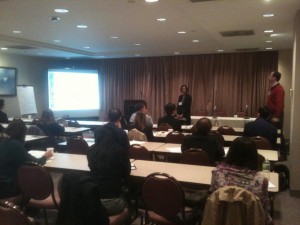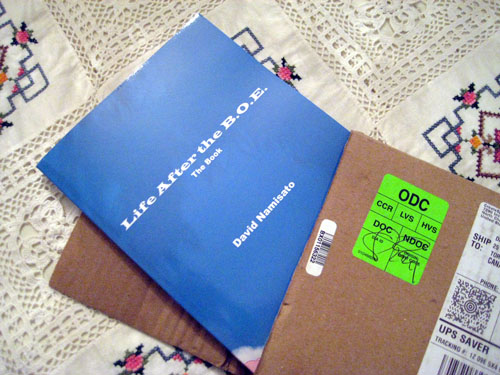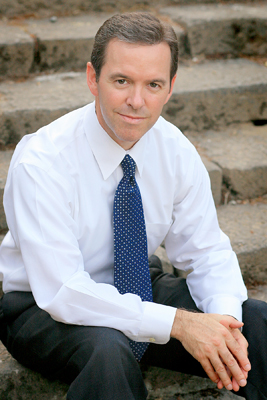New Facebook group for Brooklyn JET Alumni
Update: I originally set this up as a FB “page” but have now more wisely switched it to a “group.” So make sure to sign up for the “group.”
For anyone who’s interested, I’ve set up the Brooklyn JET Alumni group on Facebook for JET alumni who live in Brooklyn, are from Brooklyn or are just interested in Brooklyn.
Here’s the link: https://www.facebook.com/groups/319357708081547/
I’ve had an informal email list for a few years, since I live in Brooklyn. And it was just time to turn it into a Facebook page. It’s not an official chapter or sub-chapter. Just an informal group for the convenience of those of us living in Brooklyn-cho.
BTW, if anyone wants to come up with a better graphic, please feel free to make one and send it to me at jetwit [at] jetwit.com.
Now On Sale: Life After the B.O.E. the Book
Life After the B.O.E. the Book is now on sale at Amazon.com and CreateSpace!


Amber Liang and Sean Harley explain the art of getting a job without ever asking (i.e., informational interviews). (Steven Horowitz)
By Carolyn Brooks (Ishikawa-ken, 2006-11) for JQ magazine. Carolyn is co-author of the blog MadSilence–a cross-cultural blog written with her father–and a current culture/education related job-seeker in the New York area available for full-time or consulting work.
JET alumni from all walks of life gathered this weekend at the Nippon Club in New York City to talk about something important to us all: jobs and how to get them. The Career Forum is a much-anticipated event, with JETAA New York providing a varied and well-planned series of presentations for recent returnees and new career searchers alike.
“We hold this event annually to help the recent returnees get settled back in New York, provide job hunting advice and techniques for highlighting the JET experience on their resume, and give them the opportunity to meet alumni and recruiters in their possible career fields,” said JETAANY president Monica Yuki (Saitama, 2002-04). The Career Forum achieved all those objectives with flying colors, as well as giving us recent returnees a taste of home, which for many of us suffering from reverse culture shock was as welcome as the career advice.
Evan Hyman (Osaka, 1995-96) started the presentations off with a bang, sharing the 10 most important lessons he’s learned in his 14 years since JET. Over the years he’s worked in marketing and planning with some of the world’s largest companies (including Pepperidge Farm and Johnson & Johnson), but that doesn’t mean he hasn’t encountered the same road bumps that new jobseekers do. Some of his advice included practical matters like “Network, network, network!”; “Utilize as many recruiters as you can”; and “Your job search will be determined by the economy”; but it was his more personal advice that really struck me.
Lesson #9 was “It can take a really long time to realize what you want to do.” Mr. Hyman’s had some jobs that, while lucrative and attractive, just weren’t for him. It was those jobs that helped him find his “sweet spot” and learn skills that got him the jobs he liked. No experience is ever wasted! Lesson #5, my personal favorite, was “Have a passion for what you do!” If you work at a job you’re not interested in, you’re not going to do your best work, so find your passion and see how you can use it in a career. Read More
Justin’s Japan: Film Review – ‘Hatsune Miku Live Party 2011 39’s Live in Sapporo’

"With New York going bananas in between numbers and the room itself mimicking the Sapporo show with timed strobe and lighting effects—the theater’s management really went the extra mile—it truly felt like being at a concert." (Courtesy of Live Viewing Japan)
By JQ magazine editor Justin Tedaldi (CIR Kobe-shi, 2001-02) for Examiner.com. Visit his page here for related stories.
On Nov. 10 a one-time theatrical screening was held for a new concert film from virtual pop phenom Hatsune Miku. Entitled Hatsune Miku Live Party 2011 39’s Live in Sapporo, the film—captured in August at the 2,000 capacity Zepp Sapporo—is Miku’s latest appearance in America following a Toyota ad campaign and live gigs at L.A.’s Nokia Theatre and the San Diego Comic-Con earlier this year. (In fact, this reporter was interviewed for Japanese TV about that; click here for the news clip.)
Hatsune Miku, whose name means “first sound of the future,” is a Vocaloid (meaning machine-made vocals) digital female avatar and the most popular of Crypton Future Media characters that employ Yamaha technology to create synthesized vocal tracks, similar to Auto-Tune. In Japan, Miku is massively successful and has appeared in numerous popular video games and music videos, and her Sailor Moon-meets-Avril Lavigne image (she is a teen idol, after all) is equally fanboy and fangirl friendly.
Presented by Live Viewing Japan and simulcast in nine U.S. cities, this screening was shown to a capacity Times Square crowd. From the moment Miku’s name flashed up on the dark screen five seconds in, the audience was hooked. Wild applause, shrieks and excitement from the mostly American teens and twentysomethings in the crowd took the older folks by surprise. “This is like Paul McCartney to us,” remarked one lady several seats away. (She and her companion left about an hour in.)
For those unfamiliar with J-pop, the genre’s credo is style over substance (Katy Perry and Lady Gaga are our closest counterparts), but just like with our pop tarts, a catchy hook is a catchy hook. With a black, completely bare stage flanked by a five-piece band (yes, the music seems to be performed live), the only thing besides Miku noticeable throughout are the hundreds of lime green glow sticks pumped energetically by the fans throughout. Again, this was mirrored by the Times Square audience as one enterprising otaku passed out five blue ones (not to be outdone, he carried a massive Darth Maul-ish staff that lit up a chunk of the theater.)
For the rest of the article, click here.
***********
JETAANY held its annual Career Forum/Welcome Back Reception on Saturday at the Nippon Club in NYC. And in addition to the usual combination of useful advice, networking, natsukashii talk and reconnecting in general, this year’s Welcome Back Reception was notable for one other reason: It was attended by approximately 25 participants in Japan’s new Japan-U.S. Training Training and Exchange Program for English Language Teachers (JUSTE) program, sometimes referred to as the “Reverse JET” program.
The program selected 96 Japanese teachers of English to spend 6 months in the U.S. studying ESL teaching methodology–in English–at 6 different universities across the U.S.: Rutgers University (NJ), University of Delaware, University of Michigan, University of Texas, University of Iowa, UC Irvine and UC Davis. The teachers are in turn supposed to bring back their learning and share it with their respective school systems as part of an effort to improve English ability of Japanese students.
The Reverse JETs attending on Saturday came up from Rutgers and the University of Delaware. It was a terrific opportunity to get to know them and learn more about the program. Following a brief intro by all of the returning JETs, the Reverse JETs were asked to do the same. And as they said their names and prefectures, there was an almost instant connection as JET alums from various prefectures cheered when the Reverse JETs called out their own home prefecture.
It was also apparent that these were top rate teachers–the really genki, creative and engaged teachers you remember from your JET days. (We all were fortunate to have had at least one of these if not more.) This was made rather apparent when the Delaware contingency decided to forego the traditional introduction style and instead go with a teaching game they had all learned in class the day before. (See video below.)
Throughout the reception and the nijikai at Faces & Names, JET alumni found the Reverse JETs extremely friendly and easy to talk to. And it was interesting to hear about their situations and the parallels with our own first time experiences in Japan. For example:
- While the Rutgers participants are all living on campus in a dormitory for foreign students, the Delaware participants are all living with homestay families and generally need to rely on them for transportation to and from the campus (as they’re not permitted to drive while in the U.S.)
- Most participants were surprised to have been selected for the program. That’s because most of them hadn’t even known of the program’s existence until their principals called them into their offices and asked them if they’d like to go to the U.S. for 6 months. In same cases, participants only had hours to contact their spouse and decide whether to say yes. Though in everyone’s eyes, this was too good an opportunity to pass up, not to mention a terrific honor. They realized they had been 1 of 96 selected out of a total pool of 50,000 English teachers in Japan. It sounds like each prefecture is permitted to select a few school systems, and then the Board of Ed in those school systems chooses the teacher. Interestingly, some schools apparently passed on the opportunity because they didn’t feel they could afford to be without one of their top teachers for 6 months. And in some prefectures, the selection process is different and teachers can actually apply to be a participant.
- The teachers seemed to be aware of the costs involved in sending them to the U.S. and expressed a strong sense of obligation to study hard and share their learning upon return. Though one confessed to worrying about maintaining a delicate balance of sharing knowledge while also not wanting to be the nail that sticks up.
- And perhaps most interesting of all, in talking with one of the participants from Aichi (my JET prefecture), I learned that she grew up in Inuyama City and had JET alum and Inuyama City Council Member Anthony Bianchi (Aichi-ken, Inuyama-shi, 1988-89) as her ALT when she was a student! Now that’s full circle. (If anyone knows a good Japanese kotowaza for that idea, please share.)
Hopefully, the Reverse JETs through the U.S. will be able to find JET alumni in their area. And it would be really terrific if JETAA chapters as well as the JET alumni community in general could do its best to reach out to the participants wherever they are. They truly appreciate getting to spend time with the New York JET alumni on Saturday. Imagine how great it must feel to be from Tottori-ken and find an American who is also familiar with Tottori.
Unfortunately, they’re only here through January. So now is the time to reach out. In addition to meeting some great people, you’ll also be helping to support a very unique Japanese education program that we hope will continue in the future and grow to meet the English learning needs of Japan’s society.
Life After the B.O.E. goes on sale next week.
Direct links to Amazon and CreateSpace, which are selling the books, will be posted at that time, but in the mean time, here are some teasers:
The proof peaking out of the box it came in.

Read More
JETwit Career Update 11.09.11
JETwit Career Update is a new feature where JETwit will list any JET alums who have recently (loosely interpreted) found a new job, gotten a promotion, started a new business, been elected to an office, started a new grad program or have any other career developments to share. You probably see lots of job listings, so I thought it would also be interested to know who’s finding work and what kind of work people are finding.
Let us know about yourself or fellow JET alums by sending an e-mail to jetwit [at] jetwit.com. (Make sure to include prefecture and years on JET. And of course mention if you found your job via JETwit or JETAA listings or connections.)
- Rob Cornilles won the Republican primary for the Congressional seat vacated by David Wu (D-Oregon), who resigned due to allegations of inappropriate sexual behavior. If Rob, who lost to Wu in the last election, wins this election, he would be the first ever JET alum to hold a seat in the U.S. Congress.
- Kiesha Speech (Nagasaki-ken, 2000-02) was elected to the Oak Park School Board last night in Oakland County, Michigan. (http://detnews.com/apps/pbcs.dll/section?Category=POLITICS01) (https://www.facebook.com/#!/kieshaspeech)
- Olivia Nilsson (Tokushima-ken 2006-08) reports she has left her position at the New York Bureau of the Yomiuri Shimbun after three years covering business and economic news. She’s now working as a researcher at Blue Heron Research Partners in NYC.
- Elizabeth Gordon of JETAA Chicago reports: “I am the new Director of Private Events at the Adler Planetarium – totally different from what I was doing, but very exciting!”
- Daniel Sturgeon, a Political Analyst and Speechwriter at the Consulate General of Japan in Atlanta who also previously worked as a Chunichi/Tokyo Shimbun staff reporter in D.C. says: “My last three jobs have been Japan related and were found either at JETwit or the JETAA network.” Daniel also mentioned that he is now a Rotarian, so if anyone is interested in applying for their scholarship, he’s a point of contact.
- Shane Taber (Monbusho English Fellow, Nara-ken, 1979-81) says: “After a nearly 30 year “break”, 4 kids (now all grown), plus years of public school teaching innorthern California, I am happily back in Kansai teaching full time at Kobe College High School for the next several years. While I became aware of this job opening through other sources, this teaching position was also listed in JETwit’s job section in 2010. Of course, having been an MEF was a big plus in landing this position, I’m sure! I’d love to hear from other former MEFs from the late ’70s/early ’80s who are also in Japan now.” (JETwit note: There’s a LinkedIn group for MEFs. Please join if you haven’t yet!)
- And Kay Munroe-Johnson in Atlanta says: “This is great to see! I rejoice with all of you in achieving such great job success! Maybe I will have a report to share soon as I am looking for a job in (near Atlanta). Thanks JetWit for your dedication and support of all of us JET Alums!”
- And Greg Beck (CIR Hiroshima-ken, 2006-11) (listed in the previous JETwit Career Update) says: “It is great not just to be employed, but to work in the field I love, not just for a paycheck. That’s a tragically rare thing right now, and a huge concern I had as my JET career wound down. Basically, JETwit ROCKS!”
JET alum Rob Cornilles wins Republican primary for Oregon Congressional seat
 JET alum Rob Cornilles, a sports business consultant, has won the Republican primary for a seat in the U.S. House of Representatives representing the Portland-area district. The primary was part of a special election being held in the wake of the resignation of David Wu (D-Oregon) who resigned earlier this year due to allegations of sexually inappropriate behavior. Cornilles was also the previous Republican winner and lost to Wu in a close race in the last election.
JET alum Rob Cornilles, a sports business consultant, has won the Republican primary for a seat in the U.S. House of Representatives representing the Portland-area district. The primary was part of a special election being held in the wake of the resignation of David Wu (D-Oregon) who resigned earlier this year due to allegations of sexually inappropriate behavior. Cornilles was also the previous Republican winner and lost to Wu in a close race in the last election.
Cornilles will next face the Democratic primary winner Suzanne Bonamici, an Oregon state senator.
Here’s a link to the full article: http://www.katu.com/news/local/133507753.html
Here’s a link to Rob’s campaign website: http://www.cornillesforcongress.com/
BTW, if anyone knows Rob’s prefecture and years on JET, please post here or e-mail to jetwit [at] jetwit.com. Yoroshiku!

Suzanne Bonamici (D) (left) and JET alum Rob Cornilles (R) (right)
“Fiber Futures: Japan’s Textile Pioneers” and “Postcards from Japan: Messages from Tohoku Artists” @ Japan Society until 12/18/2011
Carolyn Brooks (Ishikawa-ken, Kanazawa, 2006-11) is co-author of the blog MadSilence–a cross-cultural blog written with her father–and a current culture/education related job-seeker in the NY area available for full-time or consulting work.
Yesterday I had the opportunity to visit the Japan Society in NYC. Hidden behind an outwardly unassuming facade across the street from the United Nations, The Japan Society has been promoting Japanese-American relations since 1907. Inside, the Society shows its true character as the indoor gardens, water features, and shoji-inspired walkways wow visitors as much as the broad range of classes, exhibitions, and lectures they hold each year.
Currently showing (until December 18th) is “Fiber Futures: Japan’s Textile Pioneers.” It’s a collaboration between The Japan Society and Textile Network Japan along with Tama Art University Museum. As you enter the exhibit, you walk through the first piece of art! The doorway is covered with a noren, or traditional door curtain, made of space-age materials that look like watered silk and gold leaf. It was one great example of how the 30 artists who contributed pieces combined traditional techniques and modern materials to show the versatility and beauty of textiles….
CLICK HERE TO READ THE REST OF THE POST…
Jewpanese – Where Jewish and Japanese converge
 For any Jewish and Jewpanese JETs and alums out there, you may be interested in the “Jewpanese“ Facebook group started by my friend Paul Golin, who serves as Associate Director for the Jewish Outreach Institute and whose wife happens to be Japanese (and an active member of NY de Volunteer!)
For any Jewish and Jewpanese JETs and alums out there, you may be interested in the “Jewpanese“ Facebook group started by my friend Paul Golin, who serves as Associate Director for the Jewish Outreach Institute and whose wife happens to be Japanese (and an active member of NY de Volunteer!)
Here’s the link to “Jewpanese – Where Jewish and Japanese converge“: https://www.facebook.com/JewishJapanese
Posted by Ashley Thompson (Shizuoka-ken, 2008-2010) of Surviving in Japan: without much Japanese and Lifelines columnist for The Japan Times.
I wrote Part 1 of this “Giving Birth in Japan” series last week, so if you haven’t read that already, you may want to before reading Part 2 below.
********
As I was being stitched up, I started shivering uncontrollably. Of course, the temperature in the room had been pretty low as I was sweating and hot throughout the labor and delivery. My husband changed the temp while the nurses helped me change out of my sweaty long t-shirt. (Note: this particular clinic, and probably many others, provide hospital gowns that women typically wear throughout their stay. However, the gowns at this clinic were really uncomfortable and stiff-feeling, so I brought my own clothes to wear for the birth and for the stay. We discussed this with one of the midwives at the clinic beforehand so it wasn’t an issue.)
The nurses also had to put these giant pads on me that were sort of like a diaper as all of the blood came out (sorry, graphic I know), which they changed several times right after I had given birth.
After all this, baby was cleaned up and I got to hold her, and also try nursing her. One important thing I should point out is that depending on where you deliver, the midwives or nurses may have different ideas on the best way to breastfeed. We had been warned beforehand that this clinic wasn’t that great with breastfeeding support, and it seemed like almost every nurse/midwife had a different idea about how it should be done. Initially, they only had the baby feed for a few minutes on each side, and then took her away for some tests. One of the nurses explained that the baby should only eat for 5 minutes on each side and then switch, and many of the others nurses also reemphasized this, but some of them didn’t care about the length of time. And everyone had different ideas of how to manually express milk as well, but a pump was frowned upon).
I was still exhausted and a little out of it for that part, but if I went through this process again I probably would have requested to let her feed longer if she was willing to, instead of just pulling her off after less than 10 minutes. I also would have wanted more skin-to-skin time with the baby, since I was fully clothed again (like I mentioned in the previous post, modesty is preferred) and baby was bundled up as well.
I had to go to the bathroom around this time (it had been a while since I last peed), so asked if I could go. The nurse gave me some cleansing wipes, a pad, etc., and walked with me to the bathroom. I have to tell you, I was so weak at this point, and sore, that it was difficult just getting there. As I was going about my business, I became really faint and lightheaded. My head felt heavy and I had to lean over between my knees.
I should make a brief note that I’ve had various instances happen in my life when I’ve become very lightheaded and faint, and I either nearly pass out or actually do. Usually I try to lay down before I pass out completely, but sometimes it’s been hard to avoid.
So I told the nurse I was lightheaded, and she said we should walk back to the room. I tried standing up, but I found it difficult to stay standing and fell over the sink, grabbing the counter. I willed myself to stay conscious enough to walk back so I could lay down.
That didn’t happen. The nurse called another nurse and they both held onto me as I stumbled my way down the hall. I ended up falling to the floor since I completely lost strength and neither of them could hold me up. There I was laying on the floor in the hallway, just outside the LDR room as one of the nurses called for my husband. The last thing I remember before I blacked out was my husband wrapping his arms around me to pull me up. –– CLICK HERE to read the rest of the post.
Summary of JETAA USA Fund disbursements
***************
Thanks to JETAA USA Country Representative (and JETAA USA Fund Committee member) Megan Miller (Hyogo-ken) for the following summary of the JETAA USA Earthquake Relief Fund’s disbursements. It was originally an e-mail sent to the JETAA USA chapter officers Google Group which has been modified slightly for posting here:
Dear US Chapters,
The fund committee has been hard at work and has finalized the donations for the $76,000+ we have raised so far. I’d like to thank the committee as well as the folks at JETAANY for all of their hard work during the past 8 months, and I’d also like to thank all of you for your amazing fundraising efforts. News of JETAA’s collective, world wide fundraising efforts as JET Alumni is very much on the radar screen in Japan. It is great that we can support the people of Japan and also demonstrate the value of our network and our commitment to Japan at the same time.
To recap the fund committee’s decision, here is where we are allocating the funds raised to date:
1. Hope for Tomorrow – $25,000 (http://hope-tomorrow.jp/)
A major challenge that high school students from the Tohoku region will face is to keep from falling behind students from elsewhere in the country who are studying for their college entrance exams. The students in Tohoku graduating this March had completed their exams by the time of the earthquake, but the ones who will graduate next year are liable to fall behind due to the length of time schools have been shut down, the absence of cram schools and other supplementary educational activities during their senior year, and the trauma and family tragedies that many have to face. On top of this, they need sufficient resources to even take the university exams, which tend to require travel to Tokyo, Sendai or Hokkaido. The exam fees are likely to be waived for many students, but there is no system to support their personal travel, lodging, meals, etc. when they leave their hometowns to take the entrance exams. In many cases, these expenses can easily exceed US$1,000, which will be difficult for families who have lost their homes and businesses to muster.
In response, a group of Tokyo volunteers has launched a new NPO called “Hope for Tomorrow” that plans to help support students by covering these expenses. They have been in touch with the main high schools in Kessennuma and Ishinomaki about this initiative. Kessennnuma had the greatest need, so they have come to an agreement with the high school to start supporting their students, and they hope to expand to other schools, including Ishinomaki’s high school. They are also interested in expanding to Rikuzentakata and open to other suggestions from us about other places. (In May, they tried to speak with the Rikuzentakata authorities as well as those in the neighboring town, Ofunato, where students were attending high school since Rikuzentakata’s high school was badly damaged, but were unable to have discussions due to the overwhelming challenges school officials were facing. However, they hope to try again soon.) In addition to the helping with the exam fees, they also wish to provide mentoring services to the students and other support that can aid them before and after their exams.
Update: They have expanded to Takata High School (the Rikuzentakata HS, although temporarily being operated in an empty school in Ofunato), because of our funds. Takata High School is delighted, and things are all firmed up now. They are also operating in Kessennuma, and might expand into Ishinomaki or elsewhere if there is additional funding.
2. E.Pa+Ch – $25,000 (http://soup1993.com/epatch.html)
E.Pa+Ch stands for Youth Empowerment Iwate (direct translation: Empowerment through Participation and Challenge). This group was created by a professor at Iwate Prefectural University (IPU) who has been active in mobilizing college volunteers to work in the disaster zone through a project called “GingaNet.” The group is planning to launch a major initiative throughout the prefecture to provide tutoring to and study rooms for middle school students who have fallen behind in their studies, with IPU students acting as volunteer tutors. (This may be expanded to high school students taking university entrance exams, in which case professional juku teachers will need to be employed). The board of education expressed support for this, and the IPU professor, Yamamoto-sensei, is going to continue developing the program in consultation with the board. This innovative program was launched on Nov 1, and it possibly will be a model for other programs around Tohoku. CR Jess Wilcox and Fund Committee member Jim Gannon were interviewed regarding our involvement. Read the article here: http://www.yomiuri.co.jp/dy/national/T111104005277.htm
3. Rikuzentakata Board of Education – $10,000
This direct contribution to the BoE will help alleviate some immediate needs of the schools, possibly including the hiring of a second JET for the area. There is currently a JET in RT who replaced Monty Dickson and the BoE would like to hire a second.
4. Taylor Anderson Memorial Fund – $5,000 (http://www.st.catherines.org/tayloranderson )
Many of you are already familiar with the work that the Anderson Family has been conducting. We have made a $5,000 donation to their fund to demonstrate our collective support.
5. Grants for 2-3 JET-related orgs – $10,000+ (To Be Finalized)
We are working with Paul Yoo of volunteerAKITA and Living Dreams who worked with Mike Maher King (Smile Kids Japan). Our grants will help support their grass roots efforts of volunteering in the area, bringing in needed supplies, and ‘filling in the cracks’ where other NGO’s are unable to assist.
TOTAL = $76,000+
Also, many of you might be aware that the JETAA international meeting was held in Tokyo from Oct 21-22. The meeting was covered and televised by NHK news. We also met with various government ministers who thanked us for our efforts to support Japan and asked us for advice on improving the JET program.
After the meeting we volunteered alongside current JETs in Rikuzentakata. We are doing a write up of that emotional experience and will send it to you in the coming days. Being in Rikuzentakata really drove home how important our efforts are. We have the power to get our funds directly in the hands of the people making decisions on the reconstruction effort.
To that end we would like to encourage JETAA chapters to continue fundraising. We now have connections on the ground and can help deploy funds efficiently and effectively. We have been notified that JETAANY will not be able to host the fund next year due to tax reasons, but we will work to find another nonprofit chapter that can help support us. Thank you again JETAANY for all the extra work you took on this year to make the fund a reality!
Lastly, it is always helpful when the JET alumni community is able to remind others of the ongoing needs in Tohoku and share news of JETAA’s accomplishments with others. I strongly encourage each of you and your chapter members to reach out to local news publications, church newsletters, your college and HS alumni magazines, work newsletters, chapter newsletters, etc. A great deal of information can be found on JETwit and the JETAA USA website. You can also contact members of the JETAA USA Fund Committee or local chapter officers if you need additional information or an official representative or spokesperson.
Stay tuned for more detailed information to follow.
A (Culturally) Stimulating Interview with the Insatiable Asa Akira

“I think I have a lot of Japanese culture ingrained in me. Just from being from a Japanese family, living in Japan. The whole ‘respect your elders,’ that, to me, is the main thing that’s different between America and Japan.”
Porn porn
By Michael Karns (CIR Kobe-shi, 2001-02) for JQ magazine. Michael is an avid photographer.
The winner of five AVN Awards (like the Oscars, but without Cuba Gooding, Jr.), Asa Akira returned to the East Coast last weekend for a rare promotional trip. In the spirit of intensifying relations between our nation and Japan, we spoke with the scintillating 25-year-old superstar/native New Yorker about her Japanese roots, her favorite anime films, and the deeper cultural points that America and Japan can swap with each other.
Regarding your Japanese heritage, where is your family originally from?
My mother’s side of the family is from Osaka and my father’s side is from Tokyo, but they live in Yokohama.
You went to an American school growing up.
I did, a very prestigious American private school. It was nice.
When Japanese students relocate to America, it can be difficult adjusting. How was it for you relearning the way of life here?
I was born in New York City and I moved to Japan when I was six, so I already had a little America experience, but it was definitely a huge culture shock. Kids in Japan are really good, even American ones. So coming to New York was like, “Oh my God, these kids are 12 years old and they’re doing drugs!” It was definitely a huge culture shock, and I totally bought into it for a little bit (laughs).
You’ve got an incredible personality…
Thank you.
What do you attribute this to?
I grew up around boys; I think that has a lot to do with my sense of humor. Me and this other girl were always the only two girls in this group of boys, so I think we grew up with a really good sense of humor, you know?
So are you kind of like an otemba (tomboy)?
Yeah (laughs).
That’s my type, by the way.
Oh, good (laughs).
Regarding Japanese culture, what things do you like the most about it? Are there any films or other things that you point to as an inspiration?
I think I have a lot of Japanese culture ingrained in me. Just from being from a Japanese family, living in Japan. The whole “respect your elders,” that, to me, is the main thing that’s different between America and Japan. People in America treat old people like [expletive].
I love my grandmother, but I know what you’re talking about.
(Laughs) And they just don’t listen to older people. I think that’s weird. So that would be the main thing.
I’ll Make It Myself! — Travel Checklist: Local Foods in Hida-Takayama, Part 2
L.M. Zoller (CIR Ishikawa-ken, Anamizu, 2009-11) is the editor of The Ishikawa JET Kitchen: Cooking in Japan Without a Fight. A writer and translator for The Art of Japan: Kanazawa and Discover Kanazawa, ze also writes I’ll Make It Myself!, a blog about food culture in Japan.
Travel Checklist: Local Foods in Hida-Takayama, Part 2
To recap– In September, a friend and I traveled to Takayama, about 3 hours from Kanazawa. Located in Gifu near the border of Nagano, the old towns of Hida (飛騨) and Takayama (高山) are a food tourist’s paradise. Since the town is quite small, most of these foods can be found in stands or restaurants near Takayama Station and nearby morning markets.

CLICK HERE to read the full post.
By Sierra Soleil (Fukushima-ken, 2000-02) for JQ magazine. Sierra works at an ESL school in Manhattan. He enjoys teaching, writing, and riding his bike.
The first weekend of November marked the ninth annual Japan Arts Matsuri (JAM) in New York, this year at the Theater for the New City in the East Village. With about 30 volunteers and a handful of business sponsors, JAM put on an excellent show for roughly a thousand people over the three exciting days.
The entryway and lobby of the theater was crammed with tables selling everything from okashi and yakisoba to clothes and handicrafts, though most people in the know went directly for the Sendai miso cream puffs, and for good reason. There were even two carnival games: a simple one involving throwing a plastic katana at prizes, and an incomprehensible one where people poked little cookies with needles for some reason. Nearly every table was also raising money for earthquake/tsunami relief.
Every day of the three-day matsuri had music and dance performances, but Saturday was Talent Night, where performers could compete for a special invitation to perform at next year’s JAM. I wasn’t sure what to expect from Talent Night, which was good, because it was as wildly erratic as any cross-section of modern Japanese music and dance should be. The first act I caught was Robin’s Egg Blue, a cheerful acoustic pop group. They were followed by a band called Firesign, which was meant to be metal, though any spell they cast dissipated immediately when, as they left the stage, one of the emcees decided to reassure us that they were all very polite in person. After that there were modern and traditional dances, a gospel singer, a karaoke cover of Cee Lo Green’s smash hit (the “Forget You” version, of course), and a fascinating collaboration between a belly dancer and a beatboxer.
The show was billed as being like Amateur Night at the Apollo, and there was some resemblance. The acts were short, and before each intermission the audience chose their favorite via applause. Looking at the lineup, it occurred to me that JAM’s offering was a lot more diverse than anything I’ve seen at Amateur Night. One of the matsuri’s goals is to share Japanese culture with Americans, and the lesson to take from Talent Night is that culturally, the Japanese really are into everything. It also occurred to me that the power to vote by cheering for a performer we liked meant a lot less without the power to impeach them by booing.
I came to Talent Night specifically to meet with JET alumna Kirsten Phillips (Niigata-ken, 2005-08), a member of the Yosakoi Dance Project 10tecomai. The first impression she makes is everything a JET is supposed to be: energetic, cheerful, with a kind of wide-eyed enunciation that makes everything sound exciting. She went directly from teaching in Japan to teaching special education in New York, and it immediately seems like she would be good at it.






